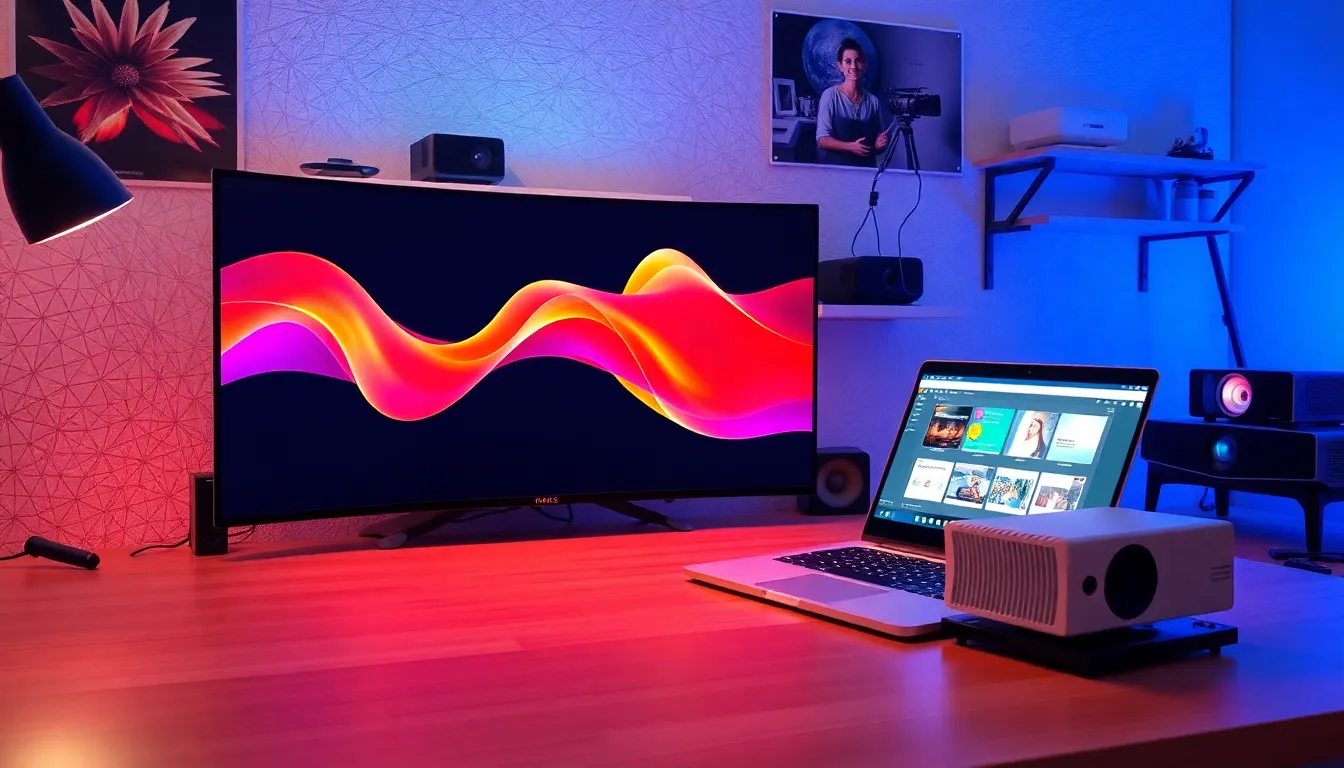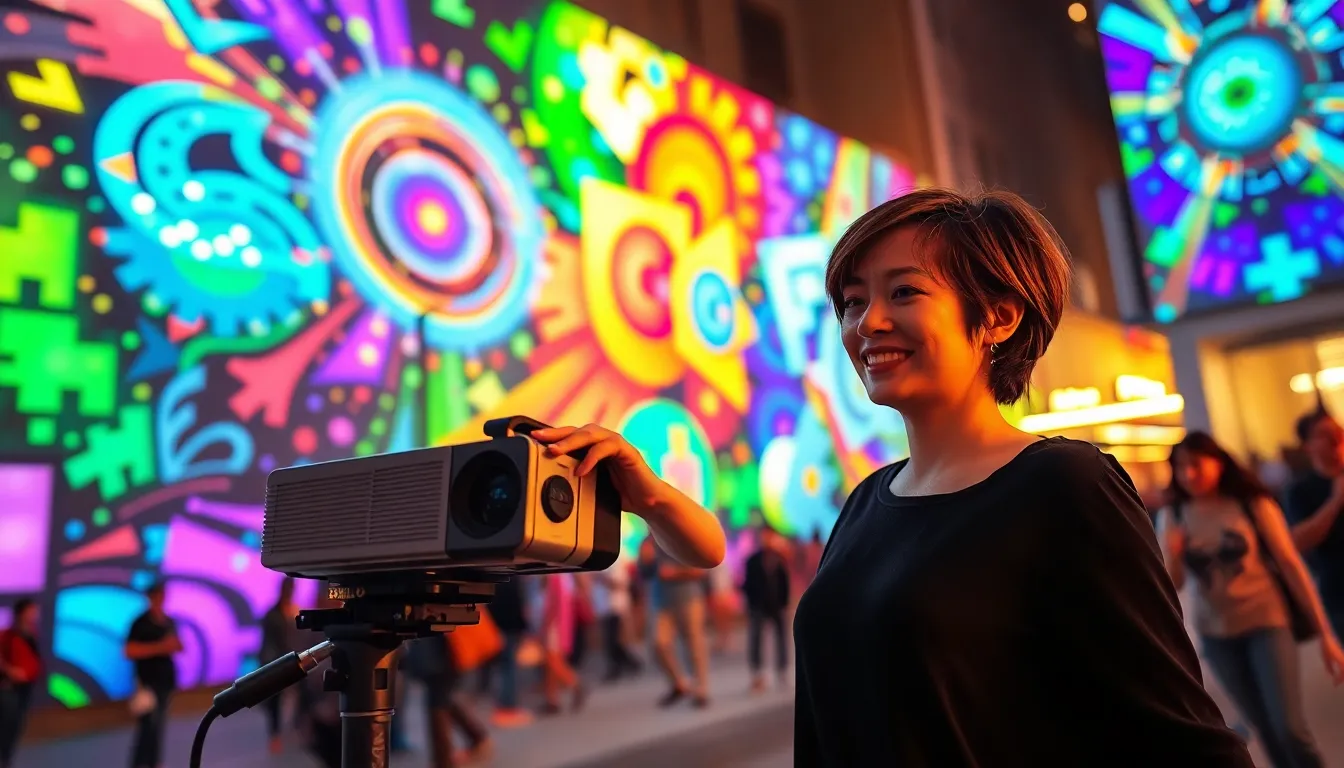In a world where creativity knows no bounds, projection mapping has emerged as a game-changer, transforming ordinary spaces into extraordinary visual experiences. Imagine turning a bland wall into a vibrant canvas that dances with light and color. For those eager to dive into this captivating art form without breaking the bank, free projection mapping software is the golden ticket.
Table of Contents
ToggleOverview of Free Projection Mapping Software
Free projection mapping software offers users the tools needed to create immersive visual experiences at no cost. These programs often come equipped with essential features, allowing both beginners and experienced users to experiment with projection techniques.
Popular Free Options
- Blender: Blender is an open-source 3D creation suite, known for its powerful rendering capabilities. Users can design intricate 3D models and animate them effectively for projection purposes.
- Magician: Magician is a dedicated projection mapping software. It provides a user-friendly interface and essential mapping tools, making it accessible for users with varying levels of expertise.
- MapMap: MapMap is a lightweight option that focuses on real-time mapping. It’s ideal for live performance settings, providing quick adjustments and visual effects.
Feature Highlights
Free software often lacks some advanced features found in paid versions but typically includes:
- User Interface: Many free options maintain intuitive interfaces, enhancing ease of use for newcomers.
- Importing Media: Users can usually import images, videos, and textures to personalize projection content.
- Basic Effects: Free software typically includes fundamental effects like cropping, blending, and warping, essential for effective projection mapping.
Community and Support
An active online community surrounds many free projection mapping software options. This offers users access to forums, tutorials, and shared projects, enhancing learning and skill development. User-generated resources often supplement the software, providing valuable insights.
Conclusion
Free projection mapping software serves as an excellent entry point for creating captivating visual displays. Users benefit from accessibility, essential tools, and a supportive community, enabling exploration in the dynamic world of projection mapping.
Features to Look for in Free Software

When selecting free projection mapping software, certain features enhance the user experience and output quality.
User Interface and Ease of Use
User-friendly interfaces streamline the mapping process. Software with intuitive layouts allows users to navigate tools and options efficiently. Clear functions, drag-and-drop design elements, and accessible tutorials contribute to a smoother learning curve. Easy-to-use software empowers users to focus on creativity without grappling with navigation complexities.
Supported File Formats
Supported file formats play a crucial role in projection mapping. Software should accommodate various media types, including images, videos, and audio files. Popular formats such as JPEG, PNG, MP4, and WAV enable flexibility in creative projects. Compatibility with multiple formats ensures users can work with their preferred media, enhancing the overall quality of visual displays.
Compatibility with Hardware
Compatibility with hardware significantly affects performance. Free projection mapping software should function well with various projectors, graphics cards, and computers. Ensuring the software works seamlessly with different operating systems, such as Windows and macOS, broadens user accessibility. Checking hardware requirements ensures users achieve optimal results without limitations during the mapping process.
Popular Free Projection Mapping Software Options
Various free projection mapping software options provide essential tools for creating immersive visual experiences. Each option caters to different user needs and skills.
Software 1: Overview and Key Features
Blender stands out as a versatile free software option. It’s renowned for its robust 3D rendering capabilities, making it suitable for complex projection mapping projects. Key features include:
- 3D Modeling: Create intricate 3D designs.
- Animation Tools: Animate objects for dynamic presentations.
- Rendering Engine: Utilize Eevee and Cycles for realistic effects.
- Community Support: Access numerous tutorials and forums for learning.
Blender’s complexity may require a learning curve, but its extensive features make it a favorite among advanced users and creatives.
Software 2: Overview and Key Features
Magician offers a user-friendly interface tailored for beginners. Users can quickly dive into the world of projection mapping without extensive technical knowledge. Key features include:
- Simple Interface: Intuitive layout eases navigation.
- Media Importing: Supports various formats, including images and videos.
- Pre-set Effects: Includes basic animation and mapping effects.
- Live Performance Capability: Enables real-time interaction for events.
Magician’s straightforward design appeals to educators and artists seeking to create visually engaging displays without technical barriers.
Software 3: Overview and Key Features
MapMap excels in real-time mapping, making it a preferred choice for live performances. Its functionality is beneficial for artists who require immediate adjustments during shows. Key features include:
- Flexible Projection: Supports multiple projectors for expansive displays.
- Real-time Control: Adjust visuals on the fly during events.
- Layer Management: Organize media into layers for better control.
- Open-source Community: Benefits from continuous updates and support.
MapMap’s focus on live interaction fosters creativity, ideal for performers looking to enhance their visual presentations.
Tips for Getting Started with Projection Mapping
Getting started with projection mapping involves careful planning and execution. Following a structured approach enhances the creative process.
Setting Up Your Project
Setting up a projection mapping project begins with selecting a suitable surface and outlining the desired visual theme. Users should gather all media elements, such as images and videos, in compatible file formats like JPEG, MP4, and WAV. Users must also choose free projection mapping software that meets their needs, such as Blender or Magician. Once the software is installed, users should familiarize themselves with the interface and explore tutorials for guidance. Structuring the project with layers helps in organizing media and effects, streamlining the creative process.
Common Challenges and Solutions
Common challenges in projection mapping include misalignment and inconsistent lighting. Proper calibration of projectors ensures accurate projection, minimizing distortion. Inconsistent lighting can detract from the visual experience; using a consistent light source during performances helps maintain an even appearance. Users often encounter issues with complex media transitions. Creating simple effects and gradually adding complexity can enhance project clarity, making it easier to troubleshoot problems. Engaging with online communities provides valuable support and solutions, as users share tips and experiences related to projection mapping.
Exploring free projection mapping software opens up a world of creative possibilities for artists and enthusiasts alike. These tools empower users to transform their visions into reality without the burden of financial constraints. Each software option brings its unique strengths to the table, catering to various skill levels and project needs.
As users dive into this dynamic medium, they’ll find that the supportive online communities provide valuable resources and inspiration. By harnessing the capabilities of free software, individuals can create stunning visual experiences that captivate audiences and elevate their artistic expression. Embracing projection mapping not only enhances creativity but also fosters innovation in visual storytelling.



